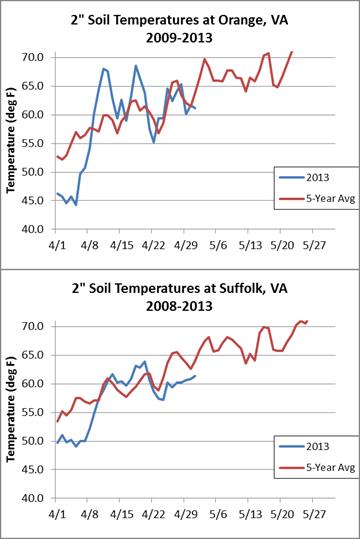It goes without saying that every year is different and this winter/spring has been wet and cold. I think that most of us have assumed that the soil temperatures are much below normal; therefore, holding off a few days with planting may be a good idea. According to 2013 and five-year historical soil temperature records at Orange and Suffolk (from the USDA-NRCS Soil Climate Analysis Network weather stations), soil temperatures have been fluctuating quite a bit.
After early-April soil temperatures proved to be much colder than normal, a week or two of warm weather put us back on track with average. Then, temperatures dropped off again. Fortunately, the last two weeks of cool weather have not lowered the soil temperatures all that much.
Although our soils have warmed substantially since early April, the temperatures are still less than optimum for soybean germination and emergence. Ideally, I like to see temperatures hold steady at 65 to 70O or above. The ideal temperature for soybean germination is 77O and the optimum range is 68 to 86O. The maximum is 94O, where germination can be inhibited. However, we can’t always wait for perfect temperatures if we are to get all of our soybeans planted on time.
Still, planting soybean in cool (<65O) will lead to delayed emergence and increased chance of seedling disease that can reduce stands, weaken emerged plants, and inhibit early-season growth. For a more detailed description of fungal seedling disease in soybean, refer to an article I wrote last May on the subject and can be found in my Virginia Soybean Update blog.
I stress that the greater time required for emergence, the greater probability that the seed will become infected with soil-borne disease. If you are planting into cool soils, I strongly suggest using fungicide-treated seed as an insurance against seedling disease. These treatments will protect the seed and seedling if emergence is delayed.
But, seed treatments should not be a substitute for other practices that encourage rapid seedling emergence. Here is my checklist for insuring a good stand free of seedling disease:
- Know the germination and vigor of your seed; adjust the seeding rate accordingly.
- Insure good soil-to-seed contact by properly setting your planter to cut through the residue and penetrate to the proper depth.
- Plant soybean seed ¾ to 1 inch deep into good soil moisture.
- Consider fungicide seed treatments if planting into cool soils.
